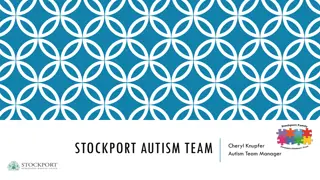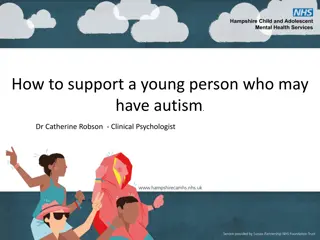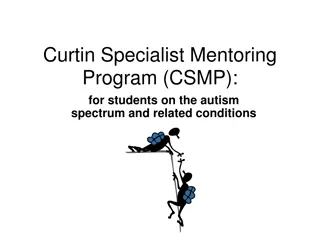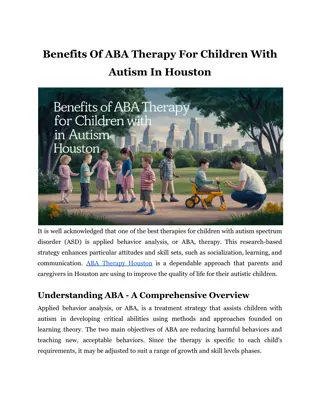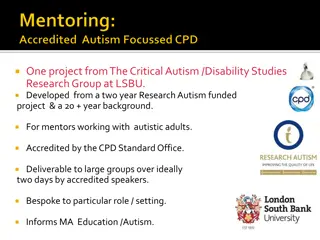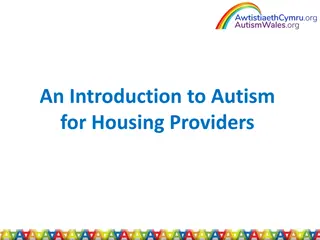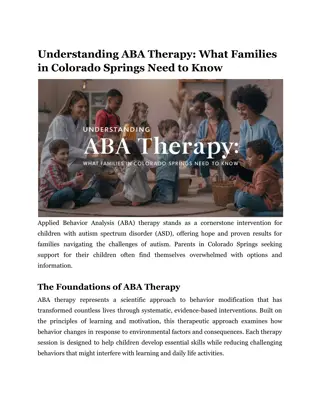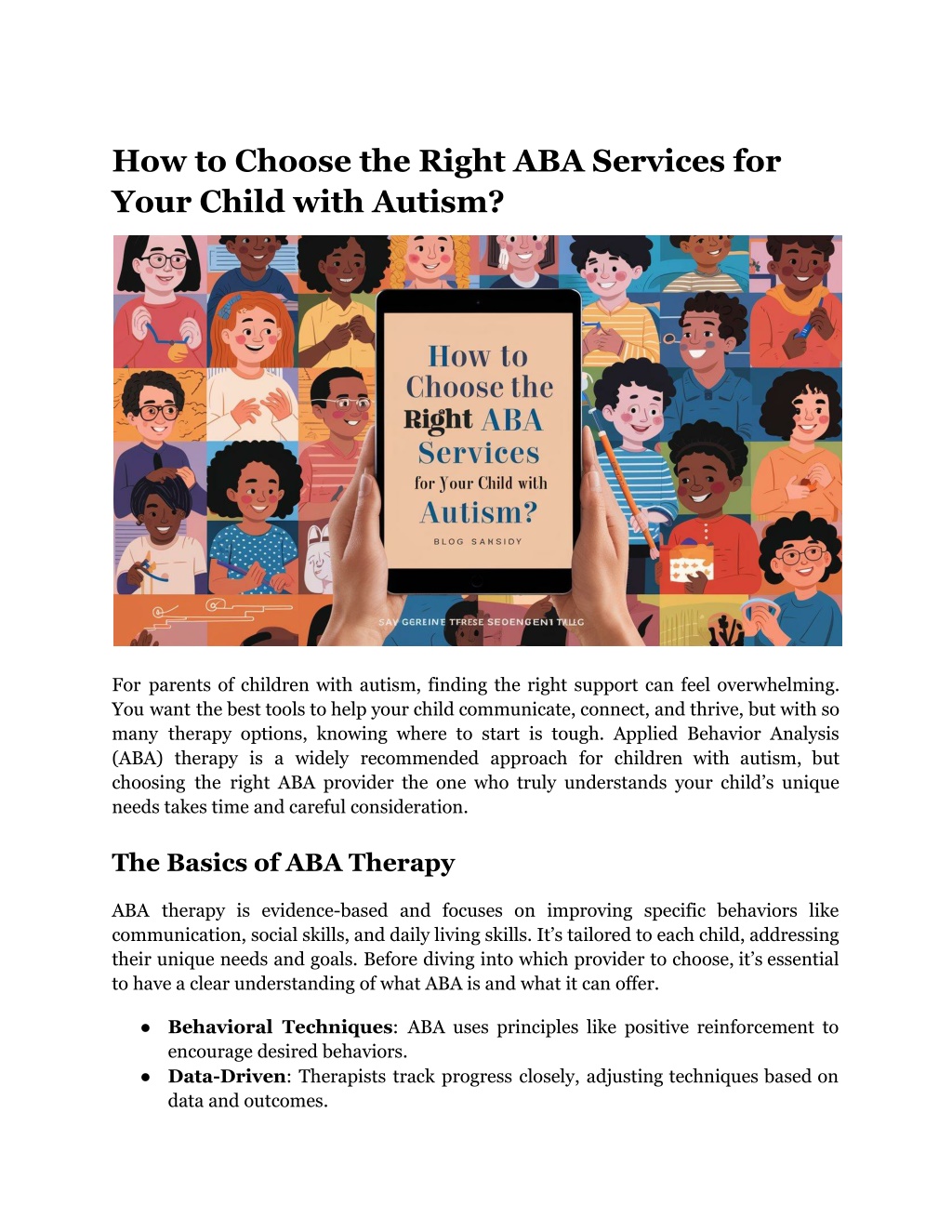
How to Choose the Right ABA Services for Your Child with Autism_
Discover practical tips to find the right ABA therapy for your child with autism. Learn what to consider for the best support.
Download Presentation

Please find below an Image/Link to download the presentation.
The content on the website is provided AS IS for your information and personal use only. It may not be sold, licensed, or shared on other websites without obtaining consent from the author. Download presentation by click this link. If you encounter any issues during the download, it is possible that the publisher has removed the file from their server.
E N D
Presentation Transcript
How to Choose the Right ABA Services for Your Child with Autism? For parents of children with autism, finding the right support can feel overwhelming. You want the best tools to help your child communicate, connect, and thrive, but with so many therapy options, knowing where to start is tough. Applied Behavior Analysis (ABA) therapy is a widely recommended approach for children with autism, but choosing the right ABA provider the one who truly understands your child s unique needs takes time and careful consideration. The Basics of ABA Therapy ABA therapy is evidence-based and focuses on improving specific behaviors like communication, social skills, and daily living skills. It s tailored to each child, addressing their unique needs and goals. Before diving into which provider to choose, it s essential to have a clear understanding of what ABA is and what it can offer. Behavioral Techniques: ABA uses principles like positive reinforcement to encourage desired behaviors. Data-Driven: Therapists track progress closely, adjusting techniques based on data and outcomes.
Personalized Approach: Each ABA plan is customized, ensuring that goals are relevant and achievable for the individual child. Key Point: Knowing how ABA works will help you recognize quality providers and understand the goals of the therapy. Assess Your Child s Specific Needs Every child on the autism spectrum is unique, with their own strengths, challenges, and needs. To choose the right ABA therapy services, start by understanding your child s current skills, areas for improvement, and overall goals. Questions to Guide Your Assessment What skills are we hoping to build? This could include social skills, communication, self-care, or academic abilities. Are there specific behaviors we want to address? Identify any behaviors you want to reduce or change, such as aggression, difficulty focusing, or social withdrawal. What type of environment works best? Some children benefit from ABA services at home where they feel comfortable, while others thrive in structured clinical settings. Key Takeaway: Define your child s goals and environment preferences. This will help you match their needs with the right type of ABA services. Explore Types of ABA Services Available ABA services come in various formats and structures, each suited to different needs. Knowing the options can help you choose a setup that s compatible with your child s learning style and your family s lifestyle. Type ABA Service of Description Best For Clinic-Base d ABA Delivered setting programs in a structured clinical Children who benefit from a routine environment with minimal distractions with
Home-Base d ABA Therapy provided in the home environment Children who feel more comfortable learning at home or need support in daily routines School-Bas ed ABA ABA school day or classroom integrated into a Students needing help with classroom behavior and academic skills Group ABA Involves multiple children, focusing on social skills Children working on social skills in a group setting Key Point: Choose the setting that aligns best with your child s needs and your family s lifestyle. The right setting can make a significant difference in progress and comfort. Look for Qualified and Experienced Providers The quality of ABA services largely depends on the skills and experience of the therapists and program supervisors. When researching providers, pay attention to the qualifications of the team and their approach to working with children on the autism spectrum. Board-Certified Behavior Analyst (BCBA): The BCBA is responsible for designing the therapy plan and overseeing progress. Verify that a licensed BCBA will be managing your child s program. Trained Registered Behavior Technicians (RBTs): RBTs are the therapists who work directly with your child. Look for providers with certified, well-trained RBTs. Relevant Experience: Providers with experience in ABA services for autism and specific behavioral issues can often offer better support. Key Takeaway: A skilled, experienced team can make a significant difference. Don t hesitate to ask about credentials, training, and specific experience with autism. Consider the Structure and Frequency of Therapy Sessions Consistency is key in ABA therapy. The frequency and length of sessions depend on your child s needs and goals, but most programs recommend multiple hours per week for effective results. Session Length: Typical ABA sessions range from one to three hours, depending on the child s attention span and endurance.
Frequency: Many ABA programs recommend 10-40 hours per week, based on the intensity of the program and the child s needs. Flexibility: Choose a provider with flexible scheduling options if you need therapy to fit around other activities or school schedules. Key Point: Consistent, frequent sessions often yield better outcomes. Be realistic about your availability and choose a provider who can work within your schedule. Evaluate the Provider s Approach to Data and Progress Tracking ABA therapy is data-driven. Quality providers continually monitor a child s progress and make adjustments based on the data they collect. Ask potential providers how they measure success and track progress. Data Collection Methods: Providers should use consistent methods to collect data on behavior, progress, and goal achievement. Regular Progress Updates: A reputable provider will offer regular updates on your child s development and explain any necessary changes to the therapy plan. Goal Reviews: Periodic reviews of therapy goals ensure that progress is on track and that the plan remains relevant to your child s current needs. Key Takeaway: Choose a provider with a structured, transparent approach to data and progress tracking. This ensures that the therapy remains effective and that you re informed every step of the way. Check for a Family-Centered Approach An ABA program works best when it includes the family. A family-centered approach encourages parents to play an active role, reinforcing skills at home and building a strong support system for the child. Parent Training: Some providers offer training sessions for parents, teaching them ABA techniques to use in daily routines. Clear Communication: Choose a provider who values open communication and is willing to answer your questions or address concerns. Family Goals: Many families have specific goals beyond the child s therapy, such as strengthening family interactions. Look for a provider who respects these goals and integrates them into the plan when possible.
Key Point: Family involvement can significantly improve outcomes. An inclusive approach where parents learn strategies alongside the child often yields the best results. Consider ABA Services at Home vs. Clinic-Based Options Deciding whether to pursue ABA services at home or in a clinic can impact your child s comfort and progress. Home-based therapy may offer advantages like a familiar setting, while clinic-based programs provide structure and access to specialized resources. Home-Based vs. Clinic-Based ABA Services Factor Home-Based ABA Clinic-Based ABA Setting Familiar, reduces stress Structured, environment dedicated learning Socializatio n Limited social interactions Opportunities for group-based social learning Access Resources to Relies environment on the home Access materials to specialized tools and Parental Involvemen t High techniques involvement, learn Moderate observation involvement, less direct Key Takeaway: Home-based ABA is great for comfort and routine skills, while clinic-based ABA may be better for structured learning and social skills. Assess which setting aligns better with your child s goals. Budget and Insurance Coverage ABA therapy can be costly, especially if multiple sessions are needed each week. Reviewing your budget and insurance coverage can help make the decision easier. Insurance Coverage: Some providers accept insurance or offer guidance on getting coverage. Check with your insurance provider to see what ABA services are covered. Provider Rates: Compare rates among providers in your area. Rates can vary significantly depending on the service, provider qualifications, and session structure.
Financial Aid Options: Some organizations offer financial assistance or sliding scale fees. Explore local or national autism organizations for funding options. Key Point: Choose a provider who aligns with your budget and helps navigate insurance. Financial considerations should be part of your decision-making process, especially for long-term services. Meet with Potential Providers Once you ve narrowed down your options, meeting with providers can give you a better sense of their approach and compatibility with your child. Observe a Session: Some providers allow parents to observe a session to see their style and interaction methods. Ask Specific Questions: Prepare a list of questions to better understand their experience, methods, and communication style. Assess Comfort and Fit: The provider s personality and approach should align with your child s needs. A positive and adaptable therapist can make a world of difference. Suggested Questions to Ask Providers Question Why It s Important How challenging behaviors? do you handle Reveals situations and respect for the child s needs the provider s approach to difficult What play in therapy? role do parents Clarifies the level of family involvement and any available parent training How success? do you measure Shows their methods for tracking progress and maintaining transparency Key Point: A face-to-face meeting helps ensure the provider is the right fit for your child s personality and therapy goals. Conclusion Remember, this is a partnership and a journey. The right ABA services can open doors to new skills, greater independence, and a brighter future.
What if the right support could open new doors for your childs growth? At Illuminate ABA Therapy, we re dedicated to providing individualized ABA programs that bring out the best in every child with autism. Site Article: How to Choose the Right ABA Services for Your Child with Autism?




